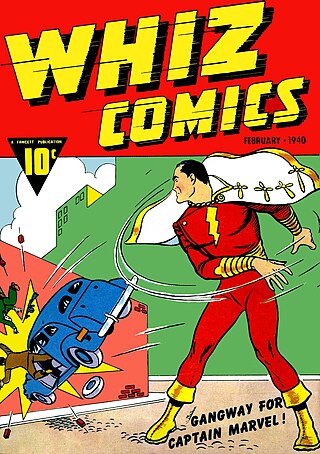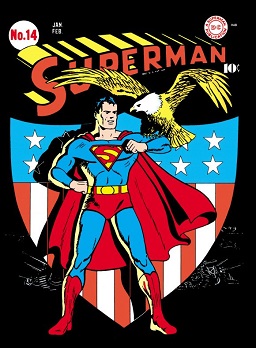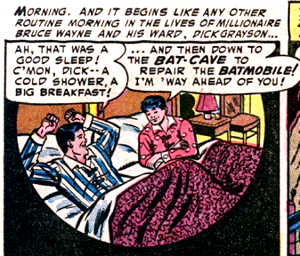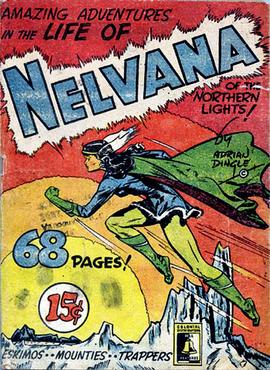
Captain America is a superhero created by Joe Simon and Jack Kirby who appears in American comic books published by Marvel Comics. The character first appeared in Captain America Comics #1, published on December 20, 1940 by Timely Comics, a corporate predecessor to Marvel. Captain America's civilian identity is Steve Rogers, a frail man enhanced to the peak of human physical perfection by an experimental "super-soldier serum" after joining the United States Army to aid the country's efforts in World War II. Equipped with an American flag-inspired costume and a virtually indestructible shield, Captain America and his sidekick Bucky Barnes clashed frequently with the villainous Red Skull and other members of the Axis powers. In the final days of the war, an accident left Captain America frozen in a state of suspended animation until he was revived in modern times. He resumes his exploits as a costumed hero and becomes leader of the superhero team the Avengers, but frequently struggles as a "man out of time" to adjust to the new era.

Marvel Comics is an American comic book publisher and the property of the Walt Disney Company since December 31, 2009, and a subsidiary of Disney Publishing Worldwide since March 2023. Marvel was founded in 1939 by Martin Goodman as Timely Comics, and by 1951 had generally become known as Atlas Comics. The Marvel era began in June 1961 with the launch of The Fantastic Four and other superhero titles created by Stan Lee, Jack Kirby, Steve Ditko, and many others. The Marvel brand, which had been used over the years and decades, was solidified as the company's primary brand.

A superhero or superheroine is a stock character who typically possesses superpowers or abilities beyond those of ordinary people, is frequently costumed concealing their identity, and fits the role of the hero; typically using their powers to help the world become a better place, or dedicating themselves to protecting the public and fighting crime. Superhero fiction is the genre of fiction that is centered on such characters, especially, since the 1930s, in American comic books, as well as in Japanese media.

The Silver Age of Comic Books was a period of artistic advancement and widespread commercial success in mainstream American comic books, predominantly those featuring the superhero archetype. Following the Golden Age of Comic Books, the Silver Age is considered to cover the period from 1956 to 1970, and was succeeded by the Bronze Age.

The Golden Age of Comic Books describes an era in the history of American comic books from 1938 to 1956. During this time, modern comic books were first published and rapidly increased in popularity. The superhero archetype was created and many well-known characters were introduced, including Superman, Batman, Robin, Captain Marvel, Captain America, and Wonder Woman.

The Avengers are a team of superheroes appearing in American comic books published by Marvel Comics, created by writer-editor Stan Lee and artist/co-plotter Jack Kirby. The team made its debut in The Avengers #1. Labeled "Earth's Mightiest Heroes", the original Avengers consisted of Iron Man, Ant-Man, Hulk, Thor and the Wasp. Captain America was discovered trapped in ice in issue #4, and joined the group after they revived him.

War Machine is a superhero appearing in American comic books published by Marvel Comics. Created by David Michelinie, John Byrne, and Bob Layton as a supporting character for Iron Man, he first appeared in Iron Man #118 (1979) and become a superhero with the Iron Man armor in issue #169 (1983). War Machine has since been established as an independent superhero and appeared in multiple stand alone series in addition to his appearances in Iron Man comics.

Johnny Canuck is a Canadian cartoon hero and superhero who was created as a political cartoon in 1869 and was later re-invented as a Second World War action hero in 1942. The Vancouver Canucks, a professional ice hockey team in the National Hockey League (NHL), currently use a hockey playing "Johnny Canuck" logo as one of their team logos. In addition, the Vancouver Canucks' American Hockey League affiliate, the Abbotsford Canucks, use it as their main logo.

Squirrel Girl is a superheroine appearing in American comic books published by Marvel Comics. Created by writer Will Murray and writer-artist Steve Ditko, the character first appeared in Marvel Super-Heroes vol. 2 #8, a.k.a. Marvel Super-Heroes Winter Special. Murray created the character out of a desire to write lighthearted stories, in contrast to the heavily dramatic tales that were then the norm in mainstream comics.
The Marvel superhero character of Spider-Man has appeared in multiple forms of media besides the comics, including on television numerous times, in both live action and animated television programs.

In comics, LGBT themes are a relatively new concept, as lesbian, gay, bisexual, and transgender (LGBT) themes and characters were historically omitted from the content of comic books and their comic strip predecessors due to anti-gay censorship. LGBT existence was included only via innuendo, subtext and inference. However the practice of hiding LGBT characters in the early part of the twentieth century evolved into open inclusion in the late twentieth and early twenty-first centuries, and comics explored the challenges of coming-out, societal discrimination, and personal and romantic relationships between gay characters.

Amazing-Man is a comic book superhero whose adventures were published by Centaur Publications during the 1930s to 1940s in the Golden Age of Comic Books. Historians credit his creation variously to writer-artist Bill Everett or to Everett together with Centaur art director Lloyd Jacquet. Amazing-Man first appeared in Amazing-Man Comics #5.
Leo Henry Bachle, a.k.a. Les Barker, was a Canadian comic book artist in the era of the Canadian Whites, and later became a comedian.

Superhero fiction is a subgenre of speculative fiction examining the adventures, personalities and ethics of costumed crime fighters known as superheroes, who often possess superhuman powers and battle similarly powered criminals known as supervillains. The genre primarily falls between hard fantasy and soft science fiction in the spectrum of scientific realism. It is most commonly associated with American comic books, though it has expanded into other media through adaptations and original works.

Superhero comics are one of the most common genres of American comic books. The genre rose to prominence in the 1930s and became extremely popular in the 1940s and has remained the dominant form of comic book in North America since the 1960s. Superhero comics feature stories about superheroes and the universes these characters inhabit.

Nelvana of the Northern Lights is a Canadian comic book character and the first Canadian national superhero, debuting in Hillborough Studios' Triumph-Adventure Comics #1. She is also one of the first female superheroes, debuting before Wonder Woman, but after Fantomah, the Golden Age Black Widow, Invisible Scarlet O'Neil and others introduced in 1940. Nelvana of the Northern Lights is Canada's first distinctly Canadian female superhero.
Canadian Whites were World War II-era comic books published in Canada that featured colour covers with black-and-white interiors. Notable characters include Nelvana of the Northern Lights, Johnny Canuck, Brok Windsor, and Canada Jack. The period has been called the Golden Age of Canadian comics.

Canadian comics refers to comics and cartooning by citizens of Canada or permanent residents of Canada regardless of residence. Canada has two official languages, and distinct comics cultures have developed in English and French Canada. The English tends to follow American trends, and the French, Franco-Belgian ones, with little crossover between the two cultures. Canadian comics run the gamut of comics forms, including editorial cartooning, comic strips, comic books, graphic novels, and webcomics, and are published in newspapers, magazines, books, and online. They have received attention in international comics communities and have received support from the federal and provincial governments, including grants from the Canada Council for the Arts. There are comics publishers throughout the country, as well as large small press, self-publishing, and minicomics communities.
Bell Features, also known as Commercial Signs of Canada, was a Canadian comic book publisher during the World War II era. They were the most successful of the publishers of "Canadian Whites", and published comics such as Adrian Dingle's Nelvana of the Northern Lights.













